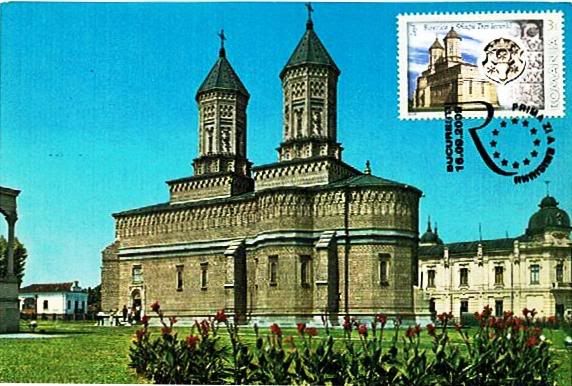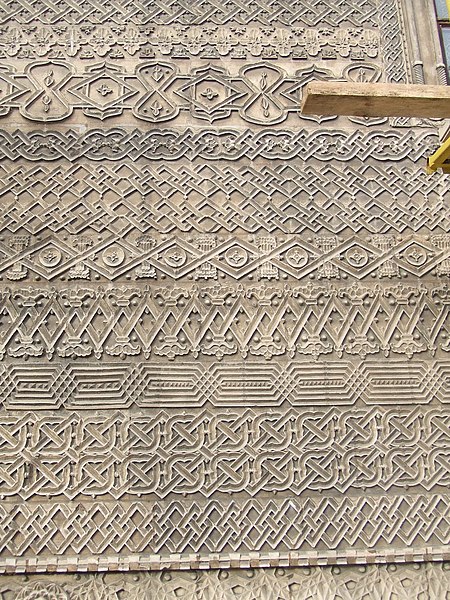"Biserica Trei Ierarhi (Church of the Three Hierarchs) is a seventeenth-century monastery located in Iaşi, Romania.
The monastery is listed in the National Register of Historic Monuments[1] and included on the tentative list of UNESCO World Heritage Site."
"The church was erected between 1637 and 1639, in the Moldavian capital, in honour of three saints (Basil of Caesarea, Gregory of Nazianzus, and John Chrysostom), and was blessed by Bishop Varlaam.
In 1640, Prince Vasile Lupu, the renowned defender of the Orthodox Church, set up here the first printing press in Moldavia and the Vasilian College, a higher education institute. In 1643, the first volume ever printed in Moldavia was issued in Iaşi.
The Trei Ierarhi Church was dedicated by Vasile Lupu to the 20 monasteries on Mount Athos.
Several Romanian royal figures are buried inside the church: Tudosca (Vasile Lupu's first wife) and Ştefan Vodă, their son; prince and scholar Dimitrie Cantemir (1673–1723); and Alexandru Ioan Cuza, the first ruler of the united Romanian principalities (1859–1866)."
"The church became renowned for the extraordinary lacery in stone which adorns the facades, from bottom to the top of the derricks. One can count over 30 non-repeating registers of decorative motives.
Western architectural elements (Gothic, Renaissance) combine with the Eastern style, of Armenian, Georgian, Persian, Arabian or Ottoman inspiration, in a totally bold conception, whose result is a harmonious ensemble.
The effusive scenery makes the church resemble a shrine of architectonic proportions, especially conceived to protect the Sfanta Cuvioasa Parascheva's relics (1641).
After the 1882 restoration, the original fresco was derusted, some fragments still being kept today in the monastery's museum.
Near the church one can find the Gothic Hall, which shelters a religious art museum.
It has, among other things, objects related to the history of the monastery. In the gate's tower (which today no longer exists), that served as belfry, Vasile Lupu had installed a huge horologe, the first public use clock in Moldavia (1654).
During the 1882 restoration, the whole mechanism was disassembled and transported to France, where it remained." [Thanks, France! Do you still need it?]
Parascheva's body, upon exhumation, was found to be INCORRUPTIBLE,
and then her relics were NOT "lost in translation"
"Christian tradition states that after an old sinner was buried near Paraskevi’s grave, the saint protested by appearing in a dream to a local monk. The vision informed the monk where the saint had been buried; when the body was unearthed, it was found to be incorruptible.[1] The relics were translated to the church of the Holy Apostles in Katikratia.[1]"
Here is a similar example of (almost) incorruptible body:
For Joe Sixpack, The Incorruptibles can only mean some cops who could not be bribed by the gangstas.
"Incorruptibility is a Roman Catholic and Eastern Orthodox belief that supernatural intervention allows some human bodies to avoid the normal process of decomposition after death.
Bodies that reportedly undergo little or no decomposition, or delayed decomposition, are sometimes referred to as incorrupt or incorruptible (adjective) or as an incorruptible (noun)."
"Although incorruptibility is still recognised as supernatural in Roman Catholicism, it is no longer counted as a miracle in the recognition of a saint.[1][clarification needed]
Incorruptibility is seen as distinct from the good preservation of a body, or mummification. Incorruptible bodies are often said to have the odour of sanctity, exuding a sweet or floral, pleasant aroma."
Wake up and smell the relics.
"In Roman Catholicism, if a body remains incorruptible after death, this is generally seen as a sign that the individual is a saint, although not every saint is expected to have an incorruptible corpse.
When the Catholic Church recognized incorruptibles, a body was not deemed incorruptible if it had undergone an embalming.
As such, although the body of Pope John XXIII remains in a remarkably intact state, after its exhumation, Church officials quickly pointed out that the Pope's body had been embalmed and that there was a lack of oxygen in his sealed triple coffin."
So the Pope was disqualified from "incorruptibility".
Retardation [relax, Sarah, it's not what you think] and Saponification
"The two main positions on incorruptibility can be summarized as an argument for a physical or environmental cause, and an argument for a spiritual cause.
Physical causes include conditions such that decomposition is significantly slowed down.
There are a number of ways of retarding decomposition, but the mechanism commonly stated is that of saponification.
Another environmental condition that can be the cause of retarding decomposition is a burial ground that is cool and dry.
The retardation of decomposition also occurs if the ground is composed of soil that is high in certain compounds that bring the bodies' moisture to the surface of the skin.
It is also suggested that bodies with low amounts of muscle and body fat tend to resist decomposition better.
The argument for a spiritual cause may include a belief that the pious nature of the individual in some way permeated the flesh (a metaphysical cause having a physical effect), or a belief that decomposition was prevented by the intervention of God, or some other supernatural agent, as the body will be resurrected later."
============
At the top, you saw the blue sky of Moldova (still called Moldavia in English), a region that is about one third of Romania.
That Moldova is the western half of historical Moldova, a Romanian land.
The Eastern half of historical Moldova is now called Republic of Moldova.
Rhetorical question: USSR, why did you annex by military force the Eastern Moldova?
Hmm, you sound like Bill Clinton...
So, MIGHT MAKES RIGHT, huh?
We'll see about that...:)
Reminder: USSR/Russia, you also have to return the Romanian Treasure!
==========
Happy Blue Monday! (meme)
Please visit: http://smilingsally.blogspot.com/






